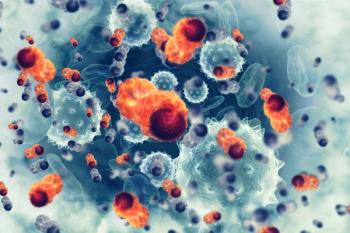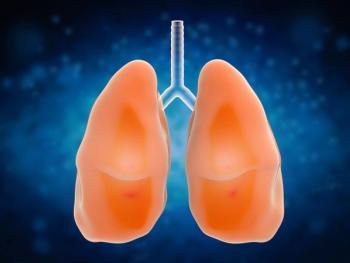
CAN-2409/EBRT Improves Disease-Free Survival in Localized Prostate Cancer
The addition of CAN-2409 to a prodrug and radiation therapy in intermediate-to-high-risk prostate cancer significantly improved cancer-specific outcomes.
CAN-2409, a localized cytolytic mechanism, administered locally and combined with an oral prodrug significantly enhanced disease-free survival (DFS) outcomes vs placebo when added to standard-of-care (SOC) external beam radiation therapy (EBRT) in patients with intermediate-to-high-risk localized prostate cancer, according to data from a phase 3 clinical trial (NCT01436968) presented at the
Data from the trial revealed that after a median follow-up of 50.3 months (95% CI, 45.37-51.29), the addition of CAN-2409 to a prodrug significantly reduced the risk of disease recurrence or death by 30% (HR, 0.70; 95% CI, 0.52-0.94; P = .0155) vs placebo. Additionally, an enhanced benefit was observed among patients not using androgen deprivation therapy (ADT; HR, 0.56; 95% CI, 0.38-0.83), particularly among those with favorable intermediate-risk status (HR, 0.47; 95% CI, 0.27-0.82).
Further data revealed that CAN-2409 significantly improved prostate cancer-specific DFS, achieving an HR of 0.62 (95% CI, 0.44-0.87; P = .0046). There was a significant increase in the proportion of patients achieving a prostate-specific antigen (PSA) nadir of less than 0.2 ng/ml in the treatment arm vs placebo, with respective rates of 67.1% vs 58.6% (P = .0164). Additionally, overall survival (OS) outcomes were similar across treatment arms, with 1 death due to disease progression in each arm; 50 patients died to causes unrelated to treatment.
CAN-2409 also elicited improved pathological complete response (pCR) rates in 2-year biopsies, at respective rates of 80.4% vs 63.6% with placebo (P = .0015). Additional data showed that a positive prostate biopsy at 2 or more years after radiotherapy due to localized cancer correlated with 10-fold higher odds of biochemical failure, 5-fold higher odds of distant metastasis, and 3-fold higher odds of prostate cancer-related mortality (all P <.00001).
“CAN-2409 significantly increased the proportion of patients achieving DFS when added to [SOC] EBRT in patients with intermediate-to-high-risk [prostate cancer], reducing that relative risk by 30%,” Theodore L. DeWeese, MD, professor of Radiation Oncology and Molecular Radiation Sciences; the Frances Watt Baker, MD, and Lenox D. Baker Jr., MD, Dean of the Medical Faculty and chief executive officer; and the vice president for Interdisciplinary Patient Care at Johns Hopkins Medicine, stated during the presentation. “CAN-2409, with those [efficacy findings] and because it was well tolerated, represents a first possible paradigm [shift] in the treatment of men with localized prostate cancer in over 20 years.”
A total of 745 patients with newly diagnosed intermediate-to-high-risk localized prostate cancer in the phase 3 trial were randomly assigned 2:1 to receive valacyclovir (Valtrex) plus either CAN-2409 (n = 496) or placebo (n = 249). Assignment was stratified by NCCN risk group and planned short-course ADT.
Those treated on trial had a median age of 69 years and were primarily White (79.3%); 85.2% had intermediate NCCN risk. The median PSA level at baseline was 6.700 ng/ml (range, 0.83-63.30), and 85.1% of patients had a Gleason score of 7. A total of 49.1% of patients had planned ADT.
The primary end point of the study was DFS. Key secondary end points included PSA freedom from biochemical failure, prostate cancer-specific outcomes, and OS.
The most common adverse effects (AEs) were infection-like in nature and included chills (25.3%), influenza-like illness (25.0%), fever (18.1%), and fatigue (17.2%). Furthermore, in the investigational and placebo arms, 12.1% vs 14.7% experienced urinary frequency, 11.1% vs 8.2% experienced nausea, and 9.4% vs 5.2% experienced headaches.
Additionally, the incidence of treatment-related serious AEs in the investigational and placebo arms were 1.7% vs 2.2%. In the respective arms, the incidence of AE-related treatment discontinuation was 5.4% vs 6.0%.
Reference
DeWeese TL, Wheeler TM, Sylvester J, et al. Phase 3, randomized, placebo-controlled clinical trial of CAN-2409+prodrug in combination with standard of care external beam radiation (EBRT) for newly diagnosed localized prostate cancer. J Clin Oncol. 2025;43(suppl 16):5000. doi:10.1200/JCO.2025.43.16_suppl.5000
Newsletter
Stay up to date on recent advances in the multidisciplinary approach to cancer.


















































































